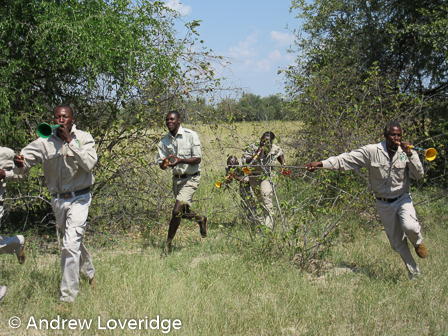News
The effectiveness of hazing African lions as a conflict mitigation tool: Implications for carnivore management
For high impact, low budget simplicity of communication, check out Lisanne’s video writes David Macdonald celebrating a remarkable paper on lion conservation.
Chasing African lions is an unexpected approach to conservation, but a new WildCRU-led study provides evidence that it can be critical in reducing livestock loss. Newly published in the journal Ecosphere, this study is the culmination of years of work by the WildCRU team which established the Long Shields Community Guardians Program: a novel conflict mitigation initiative outside Hwange National Park, Zimbabwe, that employs local residents to monitor lions and chase them into the National Park when they enter community lands.
The study focused on what factors were associated with successful chases by the Guardians, as well as what factors resulted in lower rates of livestock killing by the 15 study lions. First, the authors found that livestock depredations have indeed decreased since the 2012 initiation of the program (from ~122 depredation events annually in 2010-2011 to ~40 in 2013-2015), and that the consistency of pairing a livestock depredation with a subsequent chase by the Guardians was the biggest factor in lowering livestock depredation rates.
Lead author Dr. Lisanne Petracca, long-time WildCRU team member and Visiting Researcher, and Adjunct Professor at SUNY-ESF in Syracuse, NY, stated, “We found that even a 1% increase in pairing a livestock depredation with a chase by the Guardians can reduce livestock depredations by 12%, underscoring that even small improvements in effort can have substantive impacts. It was really exciting to show that this program works.”
The authors also found that chase success was greater in the dry season, a time when wild prey are predictably concentrated around waterholes, likely causing lions to be less reliant on domestic stock. Chase success also improved with smaller prides, as well as prides that had not lost a pride male in the last six months. Community Guardians Manager, Lovemore Sibanda, currently a DPhil Candidate at WildCRU, noted, “I had observed that the loss of a pride male, largely due to trophy hunting in this area, created social instability that seemed to push subordinate individuals into community lands and keep them from returning to the Park. It was great to see that our study supported my impression in the field, as it sheds new perspective on the unforeseen impacts of trophy hunting.”
While the study showed that the Community Guardians Program holds great promise, lions with a history of repeated livestock depredations (in this study, chronic predators of livestock killed an average of 29 animals across the 3.5-year study period; one had killed 56) were more likely to reoffend with further depredation even after multiple chases, underscoring the lack of a “silver bullet” approach to prevent all livestock depredations in the area. However, the authors also found that young animals were most responsive to the chases and represent the ideal target for future interventions.
Addressing the study, Dr. Andrew Loveridge, Senior Research Fellow at WildCRU, Oxford and Director of the Trans-Kalahari Predator Programme (TKPP) under which this program resides, stated, “The dynamics of human –lion conflicts are extremely complex and influenced by lion behaviour, environmental and human agricultural practices. This study shows that engaging local people in programs to ease conflicts with lions is a promising means of both conserving lions and protecting livelihoods”.







